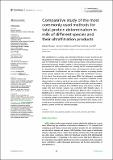Por favor, use este identificador para citar o enlazar a este item:
http://hdl.handle.net/10261/285077COMPARTIR / EXPORTAR:
 SHARE SHARE
 CORE
BASE CORE
BASE
|
|
| Visualizar otros formatos: MARC | Dublin Core | RDF | ORE | MODS | METS | DIDL | DATACITE | |

| Título: | Comparative study of the most commonly used methods for total protein determination in milk of different species and their ultrafiltration products |
Autor: | Hueso, Diego CSIC; Fontecha, F. Javier CSIC ORCID ; Gómez-Cortés, Pilar CSIC ORCID | Fecha de publicación: | 2022 | Editor: | Frontiers Media | Citación: | Frontiers in Nutrition 9: 925565 (2022) | Resumen: | Milk ultrafiltration is a widely used membrane filtration process that allows the recuperation of whey proteins in a concentrate high in total solids, which can later be transformed in multiple healthy dairy products with great prospects for the food industry. Protein content is a decisive factor for the technological performance of milk concentrates and currently, the ISO standard method for its determination is Kjeldahl, which is time-consuming and requires specific instrumentation. For this reason, the use of rapid methods to quantify protein would greatly facilitate the monitoring of the milk ultrafiltration process. In this study, the bicinchoninic acid assay (BCA), the detergent compatible Bradford assay and the Dumas method were compared to Kjeldahl protein determination to select a quick and accurate methodology suitable for milk of different species and its ultrafiltration products (retentates and permeates). The protein content obtained from Bradford assay and Dumas method in origin milk and retentate samples was consistent with Kjeldahl values. In contrast, BCA protein levels were significantly different when compared to Kjeldahl and no method was proved to be suitable for protein determination in permeate samples. The use of sodium dodecyl sulfate was also examined to improve protein measurements without success. In comparison with the official method, Bradford assay quantitatively provided the best results, and it would be recommended for a quick, economic and easy determination of total protein content in milk and retentate samples. | Versión del editor: | https://doi.org/10.3389/fnut.2022.925565 | URI: | http://hdl.handle.net/10261/285077 | DOI: | 10.3389/fnut.2022.925565 | E-ISSN: | 2296-861X |
| Aparece en las colecciones: | (CIAL) Artículos |
Ficheros en este ítem:
| Fichero | Descripción | Tamaño | Formato | |
|---|---|---|---|---|
| comparaprodu.pdf | 863,03 kB | Adobe PDF |  Visualizar/Abrir |
CORE Recommender
PubMed Central
Citations
4
checked on 18-abr-2024
SCOPUSTM
Citations
9
checked on 15-abr-2024
WEB OF SCIENCETM
Citations
8
checked on 25-feb-2024
Page view(s)
82
checked on 23-abr-2024
Download(s)
248
checked on 23-abr-2024

